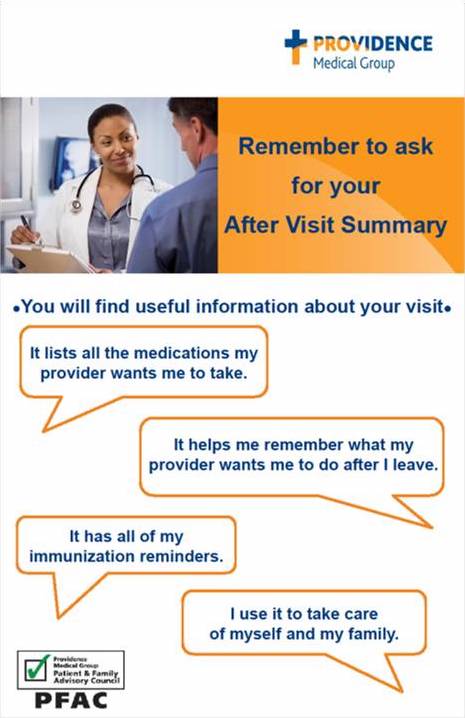
Providence Medical Group has over 45 primary care clinics and over 400 medical providers serving patients in Oregon and southwest Washington States. Thirty-three of the clinics are participating in the CMS Comprehensive Primary Care Initiative (CPC+). Additionally, PMG services include 63 specialty clinics, 5 immediate care clinics, 12 express care clinics and 2 Health Express (tele health) clinics, 5 hospitalist programs and 7 hospitals.
In building patient-centered medical homes (PCMH) in its primary care practices, PMG has strongly leveraged the “power of partnerships” with patient advisors. Patients and families were members of PMG’s Executive Patient and Family Advisory Council since its inception in 2011 and partnered with PMG on a number of quality improvement initiatives, including EPIC and My Chart. Patient and family advisors played a significant role in the development of patient materials:

- Agenda Setting Form and After Visit Summary to engage patients more in their own clinic visits
- Education about the patient-centered medical home, including a brochure entitled, “Your care, your voice, your team,” and a video explaining PCMH which is shown in clinic waiting rooms. The video is available in English, Spanish, Russian, and Vietnamese.
- Educational materials for patients on persistent pain and opiate management.
After its success with patient partners on the Executive PFAC, PMG transitioned PFACs into individual primary care clinics where patient and family advisors partner directly with leadership teams to improve the patient experience. Over 220 PFAs now serve as members of Councils at 42 PMG clinics.
Examples of projects done by clinic PFACs include:
- Monthly patient-centered newsletter, reviewed and edited by PFAC members
- Brochures, posters, and screen savers in exam rooms to introduce care team members to patients
- Real-time patient survey form available in clinic exam rooms
- Innovative new ways to recruit patient and family advisors who are more representative of clinics’ demographics
PMG’s website has a separate section about its Patient and Family Advisory Councils, inviting new patients and families to, “Join us as a patient and family advisor and share your perspective of how we can improve healthcare for you and your family.” The website lists ways in which patient and family advisors can be engaged and enumerates accomplishments of PMG’s PFACs.
PMG now also includes patient and family advisors at the medical group’s leadership collaborative. PMG recently launched an Online PFAC, a 500+ database of patients and families who want to be involved but cannot participate in a traditional PFAC format. The database also includes past members of clinic PFACs. The Online PFAC provided input for PMG’s 2018 Strategic Priorities.
According to Chantell Fitz-Amado, PMG’s Program Coordinator for Patient and Family Centered Care, “As a medical group, we are constantly looking for new ways to engage patients and families. We are excited about the potential of the Online PFAC because it provides an opportunity to capture the voices of those who may not be able to participate in a traditional meeting. It is also a way to potentially reach a more diverse population.”
Bryant Campbell has served as a Patient and Family Advisor on the Executive PFAC at PMG since 2011. He has been involved in many of the quality improvement and education projects related to the PCMH.
Bryant describes the rewards of his PFA work as, “Genuine fulfillment in grassroots efforts to bring patient engagement to the forefront. Patient care concerns are multifaceted issues extending to all socio-economic levels. As a PFAC member, I work with patient populations, ranging from those covered by ‘Cadillac plans’ to those covered by public and Medicare plans. But the issues are the same and the outcomes impact all families at a foundational level.” As a patient advisor, Bryant is committed to continuing to work collaboratively, partnering with Providence, IPFCC, other healthcare organizations and patients in improving the patient experience and strengthening patient- and family-centered care.